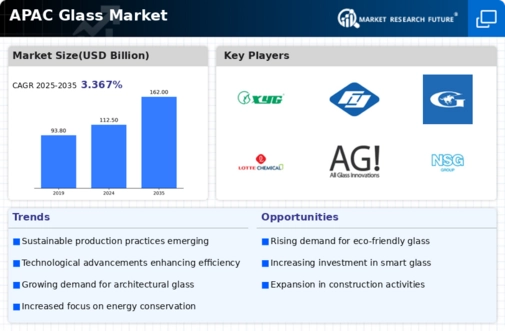Increasing Urbanization
The rapid urbanization in APAC countries is driving the glass market significantly. As urban populations grow, the demand for residential and commercial buildings increases, leading to a higher requirement for glass products. In 2025, urbanization rates in APAC are projected to reach approximately 55%, which correlates with a surge in construction activities. This trend is likely to enhance the demand for various glass types, including tempered and laminated glass, which are favored for their safety and aesthetic appeal. Furthermore, the glass market is expected to benefit from the integration of glass in modern architectural designs, which prioritize natural light and energy efficiency. Consequently, the urbanization trend is a pivotal driver, influencing both the volume and value of glass consumption in the region.
Expanding Automotive Sector
The automotive sector in APAC is experiencing rapid growth, which is positively impacting the glass market. With the rise in vehicle production and sales, the demand for automotive glass, including windshields and side windows, is on the rise. In 2025, the automotive glass market is projected to reach a value of over $15 billion, reflecting a CAGR of around 8% from previous years. This growth is attributed to the increasing consumer preference for vehicles with advanced safety features, which often incorporate laminated and tempered glass. Furthermore, the shift towards electric vehicles is likely to create additional demand for specialized glass products, such as lightweight and energy-efficient options. Thus, the expanding automotive sector serves as a vital driver for the glass market in the region.
Rising Environmental Awareness
The growing environmental consciousness among consumers and businesses in APAC is influencing the glass market. There is a notable shift towards sustainable materials, with glass being favored for its recyclability and low environmental impact. In 2025, it is estimated that the demand for recycled glass products will increase by approximately 30%, driven by both regulatory pressures and consumer preferences. This trend is prompting manufacturers to invest in recycling technologies and sustainable production practices. Additionally, the emphasis on reducing carbon footprints is leading to innovations in energy-efficient glass solutions, which are becoming increasingly popular in both residential and commercial sectors. As a result, the rising environmental awareness is a significant driver, shaping the future landscape of the glass market.
Technological Innovations in Glass Manufacturing
Technological advancements in glass manufacturing processes are transforming the glass market in APAC. Innovations such as automated production lines and advanced coating technologies are enhancing efficiency and product quality. For example, the introduction of smart glass, which can change its properties based on environmental conditions, is gaining traction in the region. This technology not only improves energy efficiency but also offers aesthetic benefits, appealing to modern consumers. The market for smart glass is projected to grow at a CAGR of around 20% from 2025 onwards, indicating a robust demand for innovative glass solutions. As manufacturers adopt these technologies, the glass market is likely to experience increased competitiveness and diversification of product offerings.
Government Initiatives for Infrastructure Development
Governments across APAC are increasingly investing in infrastructure development, which is a crucial driver for the glass market. Initiatives aimed at enhancing transportation networks, public facilities, and urban infrastructure are expected to boost the demand for glass products. For instance, the Asian Development Bank has allocated substantial funding for infrastructure projects, with estimates suggesting an investment of over $1 trillion in the next decade. This influx of capital is likely to create opportunities for glass manufacturers, as glass is essential for windows, facades, and other structural components. Moreover, the push for sustainable infrastructure may lead to a preference for energy-efficient glass solutions, further propelling the growth of the glass market in APAC.





















Leave a Comment